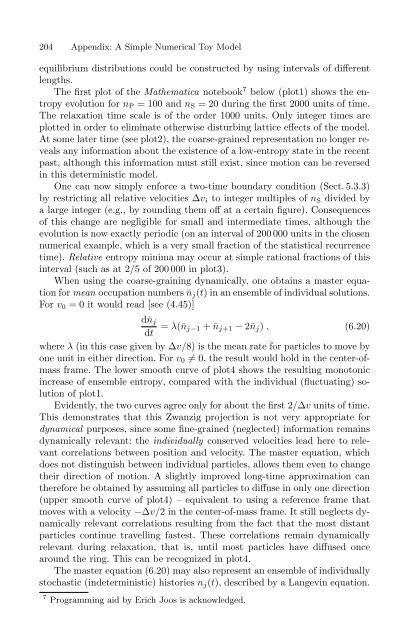The Physical Basis of The Direction of Time (The Frontiers ...
The Physical Basis of The Direction of Time (The Frontiers ...
The Physical Basis of The Direction of Time (The Frontiers ...
Create successful ePaper yourself
Turn your PDF publications into a flip-book with our unique Google optimized e-Paper software.
204 Appendix: A Simple Numerical Toy Model<br />
equilibrium distributions could be constructed by using intervals <strong>of</strong> different<br />
lengths.<br />
<strong>The</strong>firstplot<strong>of</strong>theMathematica notebook 7 below (plot1) shows the entropy<br />
evolution for n P = 100 and n S = 20 during the first 2000 units <strong>of</strong> time.<br />
<strong>The</strong> relaxation time scale is <strong>of</strong> the order 1000 units. Only integer times are<br />
plotted in order to eliminate otherwise disturbing lattice effects <strong>of</strong> the model.<br />
At some later time (see plot2), the coarse-grained representation no longer reveals<br />
any information about the existence <strong>of</strong> a low-entropy state in the recent<br />
past, although this information must still exist, since motion can be reversed<br />
in this deterministic model.<br />
One can now simply enforce a two-time boundary condition (Sect. 5.3.3)<br />
by restricting all relative velocities ∆v i to integer multiples <strong>of</strong> n S divided by<br />
a large integer (e.g., by rounding them <strong>of</strong>f at a certain figure). Consequences<br />
<strong>of</strong> this change are negligible for small and intermediate times, although the<br />
evolution is now exactly periodic (on an interval <strong>of</strong> 200 000 units in the chosen<br />
numerical example, which is a very small fraction <strong>of</strong> the statistical recurrence<br />
time). Relative entropy minima may occur at simple rational fractions <strong>of</strong> this<br />
interval (such as at 2/5 <strong>of</strong> 200 000 in plot3).<br />
When using the coarse-graining dynamically, one obtains a master equation<br />
for mean occupation numbers ¯n j (t) in an ensemble <strong>of</strong> individual solutions.<br />
For v 0 = 0 it would read [see (4.45)]<br />
d¯n j<br />
= λ(¯n j−1 +¯n j+1 − 2¯n j ) , (6.20)<br />
dt<br />
where λ (in this case given by ∆v/8) is the mean rate for particles to move by<br />
one unit in either direction. For v 0 ≠ 0, the result would hold in the center-<strong>of</strong>mass<br />
frame. <strong>The</strong> lower smooth curve <strong>of</strong> plot4 shows the resulting monotonic<br />
increase <strong>of</strong> ensemble entropy, compared with the individual (fluctuating) solution<br />
<strong>of</strong> plot1.<br />
Evidently, the two curves agree only for about the first 2/∆v units <strong>of</strong> time.<br />
This demonstrates that this Zwanzig projection is not very appropriate for<br />
dynamical purposes, since some fine-grained (neglected) information remains<br />
dynamically relevant: the individually conserved velocities lead here to relevant<br />
correlations between position and velocity. <strong>The</strong> master equation, which<br />
does not distinguish between individual particles, allows them even to change<br />
their direction <strong>of</strong> motion. A slightly improved long-time approximation can<br />
therefore be obtained by assuming all particles to diffuse in only one direction<br />
(upper smooth curve <strong>of</strong> plot4) – equivalent to using a reference frame that<br />
moves with a velocity −∆v/2 in the center-<strong>of</strong>-mass frame. It still neglects dynamically<br />
relevant correlations resulting from the fact that the most distant<br />
particles continue travelling fastest. <strong>The</strong>se correlations remain dynamically<br />
relevant during relaxation, that is, until most particles have diffused once<br />
around the ring. This can be recognized in plot4.<br />
<strong>The</strong> master equation (6.20) may also represent an ensemble <strong>of</strong> individually<br />
stochastic (indeterministic) histories n j (t), described by a Langevin equation.<br />
7 Programming aid by Erich Joos is acknowledged.



![arXiv:1001.0993v1 [hep-ph] 6 Jan 2010](https://img.yumpu.com/51282177/1/190x245/arxiv10010993v1-hep-ph-6-jan-2010.jpg?quality=85)


![arXiv:1008.3907v2 [astro-ph.CO] 1 Nov 2011](https://img.yumpu.com/48909562/1/190x245/arxiv10083907v2-astro-phco-1-nov-2011.jpg?quality=85)








![arXiv:1002.4928v1 [gr-qc] 26 Feb 2010](https://img.yumpu.com/41209516/1/190x245/arxiv10024928v1-gr-qc-26-feb-2010.jpg?quality=85)
![arXiv:1206.2653v1 [astro-ph.CO] 12 Jun 2012](https://img.yumpu.com/39510078/1/190x245/arxiv12062653v1-astro-phco-12-jun-2012.jpg?quality=85)
